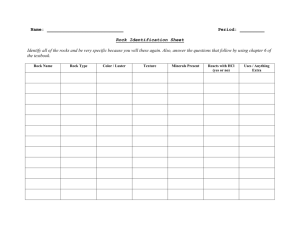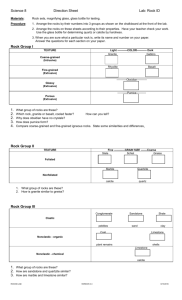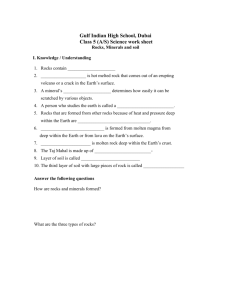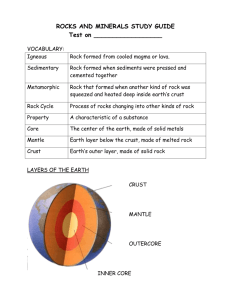Geo-tour lab due.
advertisement
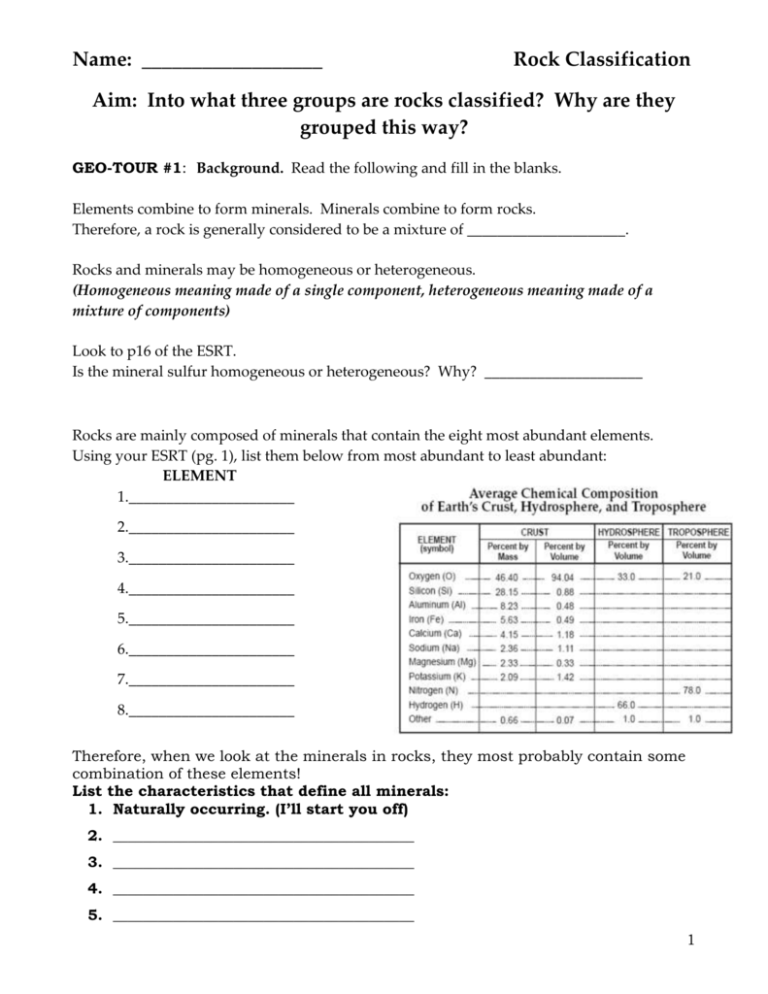
Name: __________________ Rock Classification Aim: Into what three groups are rocks classified? Why are they grouped this way? GEO-TOUR #1: Background. Read the following and fill in the blanks. Elements combine to form minerals. Minerals combine to form rocks. Therefore, a rock is generally considered to be a mixture of _____________________. Rocks and minerals may be homogeneous or heterogeneous. (Homogeneous meaning made of a single component, heterogeneous meaning made of a mixture of components) Look to p16 of the ESRT. Is the mineral sulfur homogeneous or heterogeneous? Why? _____________________ Rocks are mainly composed of minerals that contain the eight most abundant elements. Using your ESRT (pg. 1), list them below from most abundant to least abundant: ELEMENT 1.______________________ 2.______________________ 3.______________________ 4.______________________ 5.______________________ 6.______________________ 7.______________________ 8.______________________ Therefore, when we look at the minerals in rocks, they most probably contain some combination of these elements! List the characteristics that define all minerals: 1. Naturally occurring. (I’ll start you off) 2. ________________________________________ 3. ________________________________________ 4. ________________________________________ 5. ________________________________________ 1 Name: __________________ Rock Classification Aim: Into what three groups are rocks classified? Why are they grouped this way? GEO-TOUR #2—Limestone & Coal Limestone is a rock composed of the remains of marine animals (such as shells and other hard parts.) Coal is a rock composed of the remains of LONG ago (like over 300 million years ago!) plant parts (such as leaves and stems) that were buried and compacted. 1. Limestone and coal are considered rocks. Why does this seem to come into conflict with our definition of rocks being mixtures of minerals? (Hint: Look at your mineral characteristics) __________________________________________________________________________________ __________________________________________________________________________________ Therefore, we need to modify our definition of a rock and say that it can also be made of ______________ material too. 2. Copy the following definitions into your notebook: Rock: Mixture of one or more minerals, volcanic glass, organic matter, or other materials. Rock: Any solid part of the lithosphere. 3. What do we use coal for?_____________________________________________________ 4. Place a drop of dilute hydrochloric acid (HCl) on the limestone. What happens? What mineral must be the glue that is holding the shell fragments together? 2 Name: __________________ Rock Classification Aim: Into what three groups are rocks classified? Why are they grouped this way? GEO-TOUR #3—Granite 5. Look at the polished piece of granite. Even though granite can vary in color and appearance, it is predominately made up of 3 minerals. Do you see any of your new mineral friends? In the table identify the 3 minerals that are always found in granite and briefly write the physical property that helped you identify these minerals. Minerals in Granite 6. Physical Property Using the back page of your ESRT, list the 3 major elements found in these minerals? ____________________ _____________________ ________________________ This should come as no surprise! (If it does see page 11 in your ESRT!) 3 Name: __________________ Rock Classification Aim: Into what three groups are rocks classified? Why are they grouped this way? GEO-TOUR #4—Basalt tile versus Granite tile The black tile rock does look homogeneous at first glance, but it is actually a mixture of minerals too (it isn’t another exception to our rules of rocks!) However, it is made up of all dark silicate minerals. Therefore, it is challenging to distinguish one dark silicate from another (kind of like trying to find the black licorice and black jellybeans that are scattered along a blacktop driveway!) Place each tile on the scale to determine the masses. Mass of Granite Tile (more pink) Mass of Basalt Tile (black) The tiles are exactly the same size. Since they are the same size, they have the same volume. But, as you’ve just observed they do not have the same mass. So … 7. Which tile is more dense? ___________________________________________________ 8. Which tile was part of the continental crust and which was part of the oceanic crust? ________________________________ ____________________________________ Look at the other basalt rock here. Notice the rusty appearance on the outside of this rock. Observe the recently exposed surface which lacks the rust. 9. What element in the dark silicate minerals of the basalt is likely responsible for its color, density and rusting behavior?______________________ 10. What element in the silicate minerals of the granite is likely responsible for its lighter color and density? _________________________________ 4 Name: __________________ Rock Classification Aim: Into what three groups are rocks classified? Why are they grouped this way? GEO-TOUR #5—Granite and Gneiss Take a look at the samples of granite and gneiss (pronounced nice). 11. Which of your new mineral friends can you recognize in these samples? _________________________ __________________________ ________________________ 12. Granite and gneiss are chemically the same! But how are they different? Why do suspect they have different names? 13. Compare Granite and Gneiss. How are they similar and different in overall appearance? Think of their organization and patterns. Granite 14. Make a sketch each sample. Granite: Gneiss Gneiss: 5 Name: __________________ Rock Classification Aim: Into what three groups are rocks classified? Why are they grouped this way? GEO-TOUR #6—Conglomerate 15. How would you describe this rock’s appearance? Why does it look unique compared to the other rocks observed so far? __________________________________________________________________________________ __________________________________________________________________________________ 16. The individual components of this rock were once part of _________________________ 17. This rock looks a bit like an elementary school art project—a collage of things glued together! What is glued together in this case?_____________________________________ 18. The individual components are small and rounded. What processes could have produced these small fragments? _________________________________ 19. Would this rock be classified any differently if some of the pebbles were replaced by different pebbles? NO! Of course not. The rock would still be a conglomerate because the way it was formed and its overall texture would still be the same. How is this similar to the two different granitic rocks you observed in stations #3 and #4? 6 Name: __________________ Rock Classification Aim: Into what three groups are rocks classified? Why are they grouped this way? GEO-TOUR #7--???stone 20. Rub your fingers over the hand sample. What does it feel like? How would you describe its texture? __________________________________________________________________________________ __________________________________________________________________________________ 21. This rock is composed of tiny pieces of something glued together by nature. What do you think those tiny pieces are? (use the hand lens to help!) __________________________________________________________________________________ 21. This rock is called ____ _____ _____ _____ S T O N E! 23. Now look at the sand grains through the stereoscope. What is sand really? 24. Can you recognize any more of your mineral friends in the sand? List them. 25. Now look at the thin section. What is similar or common among all three examples at this station? 7 Name: __________________ Rock Classification Aim: Into what three groups are rocks classified? Why are they grouped this way? O.K.! Read the aim again for this lesson. (I’ll wait…) Have we stuck to it? Actually yes, we are right on target! Rocks are classified by their ORIGIN. By “origin” we mean: how they formed where they formed what they are made of (composition) You have just observed rocks from the three classification groupings, and now know a little about why they are grouped the way they are (even though you may not realize that yet!) Here are the three groupings and WHY they are grouped this way: IGNEOUS ROCKS: Literally means” Born of fire.” Rocks made up of silicates in crystals that are randomly arranged METAMORPHIC ROCKS: Literally means “Changed form.” Rocks made up of silicates that are organized in a pattern! (Note how this is different from igneous rocks.) SEDIMENTARY ROCKS: Primarily rocks made up of broken pieces (sediments!) 23. Now go back and classify each rock you observed during our Geo-tour as an Igneous, Sedimentary, or Metamorphic Rock. Write your answers in the table below. Name of Rock Limestone Coal Granite Basalt Gneiss Conglomerate Type of Rock COPY EVERYTHING FROM THIS PAGE THAT WAS TYPED IN BOLD CHARACTERS INTO YOUR NOTEBOOK. Sandstone 8
